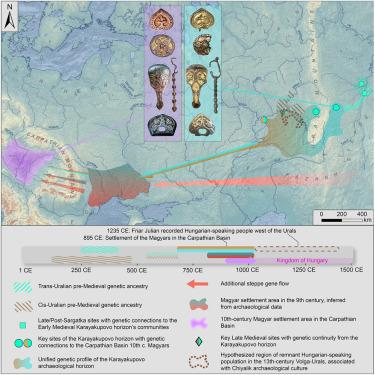Long shared haplotypes identify the southern Urals as a primary source for the 10th-century Hungarians
IF 42.5
1区 生物学
Q1 BIOCHEMISTRY & MOLECULAR BIOLOGY
引用次数: 0
Abstract
The origins of the early medieval Magyars who appeared in the Carpathian Basin by the end of the 9th century CE remain incompletely understood. Previous archaeogenetic research identified the newcomers as migrants from the Eurasian steppe. However, genome-wide ancient DNA from putative source populations has not been available to test alternative theories of their precise source. We generated genome-wide ancient DNA data for 131 individuals from archaeological sites in the Ural region in northern Eurasia, which are candidates for the source based on historical, linguistic, and archaeological evidence. Our results tightly link the Magyars to people of the early medieval Karayakupovo archaeological horizon on both the European and Asian sides of the southern Urals. The ancestors of the people of the Karayakupovo archaeological horizon were established in the broader Urals by the Late Iron Age, and their descendants persisted in the Volga-Kama region until at least the 14th century.

长期共享的单倍型确定乌拉尔南部是10世纪匈牙利人的主要来源
公元9世纪末出现在喀尔巴阡盆地的中世纪早期马扎尔人的起源仍然不完全清楚。先前的考古遗传学研究认定这些新来者是来自欧亚大草原的移民。然而,来自假定来源人群的全基因组古代DNA尚未可用来测试其精确来源的替代理论。我们从欧亚大陆北部乌拉尔地区的考古遗址中提取了131个个体的全基因组古代DNA数据,这些数据是基于历史、语言和考古证据的候选来源。我们的研究结果将马扎尔人与中世纪早期卡拉亚库波沃考古视界的人紧密联系在一起,这些人生活在乌拉尔山脉南部的欧洲和亚洲两侧。卡拉亚库波沃考古范围内的人们的祖先在铁器时代晚期在更广阔的乌拉尔地区定居,他们的后代在伏尔加-卡马地区至少持续到14世纪。
本文章由计算机程序翻译,如有差异,请以英文原文为准。
求助全文
约1分钟内获得全文
求助全文
来源期刊

Cell
生物-生化与分子生物学
CiteScore
110.00
自引率
0.80%
发文量
396
审稿时长
2 months
期刊介绍:
Cells is an international, peer-reviewed, open access journal that focuses on cell biology, molecular biology, and biophysics. It is affiliated with several societies, including the Spanish Society for Biochemistry and Molecular Biology (SEBBM), Nordic Autophagy Society (NAS), Spanish Society of Hematology and Hemotherapy (SEHH), and Society for Regenerative Medicine (Russian Federation) (RPO).
The journal publishes research findings of significant importance in various areas of experimental biology, such as cell biology, molecular biology, neuroscience, immunology, virology, microbiology, cancer, human genetics, systems biology, signaling, and disease mechanisms and therapeutics. The primary criterion for considering papers is whether the results contribute to significant conceptual advances or raise thought-provoking questions and hypotheses related to interesting and important biological inquiries.
In addition to primary research articles presented in four formats, Cells also features review and opinion articles in its "leading edge" section, discussing recent research advancements and topics of interest to its wide readership.
 求助内容:
求助内容: 应助结果提醒方式:
应助结果提醒方式:


